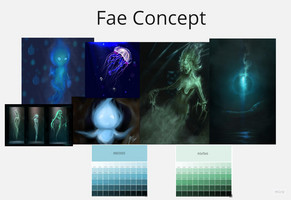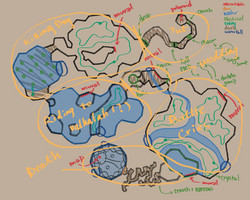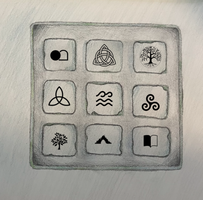Game History



The seed that would become Moraveil was our producer pitching a game about finding a map to a hidden elf village by delving into a waterlogged cave and getting out before the player drowned. This idea was proposed alongside several others, a roguelike, an ARG focused around loss of digital data, a horror game set in only four rooms, and others. When the time came to vote, Moraveil won in a landslide and we started developing the idea further. A suggestion from the writing lead turned Moraveil from a hidden elf village to another name for Celtic myth’s Land of Faerie. Half an hour of research later, the story of Cu Chullain came to the forefront.
We chose Celtic mythology, and Cu Chullain in particular, to keep that elven theme alive, as well as to use a source of inspiration that isn’t used nearly enough. Compared to the juggernauts of Greek, Egyptian, and Norse mythology, the stories of the Celts are nearly unknown. That thread of Celtic inspiration ended up influencing us throughout the entire rest of the design process, from music to visual style. We also drew visual inspiration, at least at first, from more modern works, such the works of Studio Ghibli, and the anime adaptation of Chainsaw Man. We wanted to capture their use of colour, light, and shadow for our cave adventure.
Over the course of development, some things changed. For instance, initially the game's enemies were meant to be human, fellow treasure hunters who wanted to capture Riley so he could solve the puzzles guarding the map. These eventually evolved into the ghostly, eerie entities that now roam the cave, which are coincidentally much easier to model and animate. Another piece of the game we ended up changing was the role of water. What now is a hazard that simply slows the player was once a major feature of the caves, with an entire section flooding so that the player would have to swim to navigate it. Swimming ended up being too much to add alongside our other mechanics on our timeline, so we had to adjust our wants in order to meet our goals.
One important part of our design philosophy that has been present since the beginning has been our use of colours and wanting them to have meaning. We decided that the cave, and Moraveil itself, would be associated with cool colours that evoke the unfamiliar, while Riley would be associated with warm tones that make the player think of the comfort of the home and warmth, such as the whitish-yellow of the flashlight or the yellows of the crystals near the murals.
Writing for this game was a challenge of sorts, as we had a lot we wanted to tell in a relatively short amount of time, with very few lines to work with. We wanted to, at the very least, ground our story in reality, so that our more fantastical elements could be more easily accepted. For a main character, we created Riley Power, a professor of Archeology focused on the celts and he has a sister that is sick. In our research, we found Hemochromatosis, a hereditary disease known colloquially as “the Celtic Curse”. It was one of those happy little coincidences we hear so much about in creation stories. In creating Riley, we asked ourselves about the kind of man who would delve into a dangerous cave to find a map to faerieland, and ended up with a person who’s desperate to save someone he loves, even if it means his own death, but who has not the resources to do it via medicine.
Playtesting showed that it was far too easy to get lost in the caves. While we were aiming for exploratory gameplay, players getting lost was impacting their enjoyment of the game, so changes had to be made. From the beginning of development, we had the idea of using purple crystals to subtly lead the player down the correct path. After a couple of rounds of playtesting, we realized that we needed to spell out the importance of the purple crystals, rather than just let the player figure it out. These revisions, along with some work to make the cave less confusing, led us to the version of the game we have today.
One of the more significant changes we made after extensive playtesting was the implementation of the entities’ ‘stun’ mechanic. Originally, if they spotted the player, the player would die, and they’d start back at the beginning of the game. Similarly, instead of the cave collapse sequence, the game was going to end with a flooding sequence, with the player once again being sent to the beginning of the game when they died. After some playtesting, we realized that the death mechanic had no purpose outside of the escape sequence. After this discovery, we tweaked Moraveil to make the entities stun the player instead of killing them, and relegated death to the escape sequence. We also changed the respawn point from the beginning of the game to the beginning of the escape sequence, making death less of a punishment and more of a challenge to the player. If you wish to see how the game has evolved in the time we have worked on it, please see
Files
Get Moraveil
Moraveil
Explore the alluring atmosphere of Moraveil, but do not trust everything that you see...
| Status | In development |
| Author | WCstudios |
| Genre | Adventure, Puzzle |
| Tags | Exploration, First-Person |
| Languages | English |
| Accessibility | Subtitles |
Leave a comment
Log in with itch.io to leave a comment.